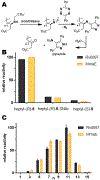Variation in biosynthesis and metal-binding properties of isonitrile-containing peptides produced by Mycobacteria versus Streptomyces
- PMID: 38895101
- PMCID: PMC11185824
- DOI: 10.1021/acscatal.4c00645
Variation in biosynthesis and metal-binding properties of isonitrile-containing peptides produced by Mycobacteria versus Streptomyces
Abstract
A number of bacteria are known to produce isonitrile-containing peptides (INPs) that facilitate metal transport and are important for cell survival; however, considerable structural variation is observed among INPs depending on the producing organism. While non-heme iron 2-oxoglutarate dependent isonitrilases catalyze isonitrile formation, how the natural variation in INP structure is controlled and its implications for INP bioactivity remain open questions. Herein, total chemical synthesis is utilized with X-Ray crystallographic analysis of mycobacterial isonitrilases to provide a structural model of substrate specificity that explains the longer alkyl chains observed in mycobacterial versus Streptomyces INPs. Moreover, proton NMR titration experiments demonstrate that INPs regardless of alkyl chain length are specific for binding copper instead of zinc. These results suggest that isonitrilases may act as gatekeepers in modulating the observed biological distribution of INP structures and this distribution may be primarily related to differing metal transport requirements among the producing strains.
Conflict of interest statement
The authors declare no competing financial interest.
Figures





References
-
- Wang L; Zhu M; Zhang Q; Zhang X; Yang P; Liu Z; Deng Y; Zhu Y; Huang X; Han L; Li S; He J, Diisonitrile Natural Product SF2768 Functions As a Chalkophore That Mediates Copper Acquisition in Streptomyces thioluteus. ACS Chem. Biol 2017, 12, 3067–3075. - PubMed
-
- Mehdiratta K; Singh S; Sharma S; Bhosale RS; Choudhury R; Masal DP; Manocha A; Dhamale BD; Khan N; Asokachandran V; Sharma P; Ikeh M; Brown AC; Parish T; Ojha AK; Michael JS; Faruq M; Medigeshi GR; Mohanty D; Reddy DS; Natarajan VT; Kamat SS; Gokhale RS, Kupyaphores are zinc homeostatic metallophores required for colonization of Mycobacterium tuberculosis. Proc. Natl. Acad. Sci. U. S. A 2022, 119, e2110293119. - PMC - PubMed
Grants and funding
LinkOut - more resources
Full Text Sources
